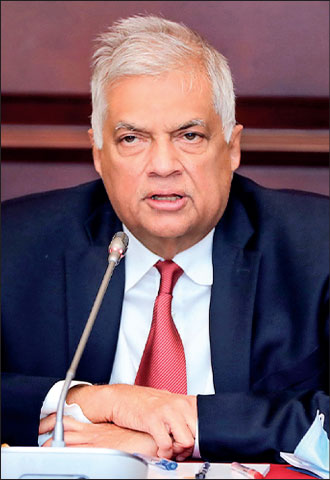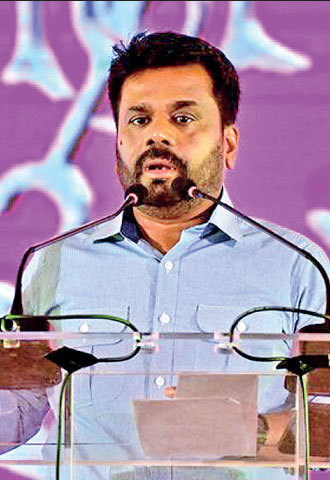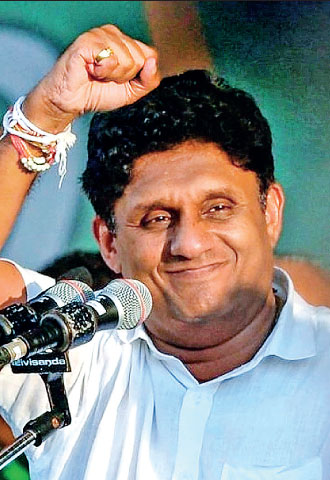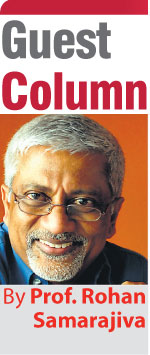Monday Apr 07, 2025
Monday Apr 07, 2025
Friday, 6 September 2024 02:29 - - {{hitsCtrl.values.hits}}

President Ranil Wickremesinghe

Anura Kumara Dissanayake

Sajith Premadasa
|
 On 21 September the voters of this country will exercise their sovereign right to elect the head of the executive. There was a time when these decisions were based on tribal allegiance—kapuwath kola, and so on. But now, the traditional parties and their networks have atrophied. Voters must decide on what they believe the various candidates will do for them and/or for the country.
On 21 September the voters of this country will exercise their sovereign right to elect the head of the executive. There was a time when these decisions were based on tribal allegiance—kapuwath kola, and so on. But now, the traditional parties and their networks have atrophied. Voters must decide on what they believe the various candidates will do for them and/or for the country.
Through their campaigns, the candidates and their proxies seek to inform us about what they will do if elected. The published manifestos provide concrete indications of future actions. This article compares the key economic positions of the three principal candidates. Because manifestos cover a lot of ground (especially when they go on for over 200 pages), not all elements can be compared. Given the state of selective default that we are still in and the existence of an IMF agreement which is the basis of emerging from that unfortunate state, attention is focused on the promises that affect the ability to service our debt, which is the objective of the IMF program, and to resume our position as a trustworthy member of the global economy.
Primary surplus
A government that generates a primary surplus does not have to borrow money to support its operations, because all the expenditures incurred in that year, other than debt servicing, can be met with the revenues raised in that year. The surplus can be used to service the debt (one year’s surplus will not be enough to pay down the accumulated massive debt).
If the government generates a primary deficit (as it has done in all years other than 1954, 1955, 1992, 2017, 2018, and possibly 2024, it must take on more debt. After 2022, that is no longer an easy option. It can engage in monetary financing as was done in the Gotabaya years, but that is foreclosed by the IMF program and the Central Bank Act, No. 16 of 2023. In addition, most people are aware of the ills of monetary financing now, having experienced the unprecedented inflation that was generated as a result, which continues to trouble us through elevated price levels.
To generate a substantial primary surplus of 2.3% of GDP, as the government committed to in the IMF agreement, it is projected that tax revenues must reach 14% of GDP by 2028 from their current level of around 10%. Expenditure reductions are also necessary if the debt is to be serviced while essential public services are adequately funded. Therefore, the most critical element of what the leading candidates propose is the impact on achieving a primary surplus.
Wishful thinking
The AKD manifesto pays no heed to the IMF agreement or the primary-balance targets. It is no different from the documents containing rosy promises published in previous election cycles. For example, the 2019 Gotabaya manifesto promised to “provide houses to those in need through easy payment plans based on the income.” AKD appears to go further: “offering financial support to newly married couples for purchasing or constructing their homes,” and “implementing programs to provide official residences for government employees close to their workplaces.”
The plain language of the former promise suggests significant outlays not only in terms of providing financial support (is this in the form of actual cash or in the form of low interest loans to the newly married?) but also in terms of an organisation to assess eligibility (does a second marriage count?) and manage disbursements. The latter promise would require the state to bear the full costs of building and maintaining the official residences. These promises, if kept, would require additional revenues to be raised if the primary balance targets are to be met.
Currently, the government generates 35% of its revenues in the form of VAT and another 35% through various taxes on foreign trade. These are indirect taxes that everyone, rich or poor, pays. Direct taxes in the form of personal and corporate income taxes contribute 20%. The balance 10% is non-tax revenue.
The AKD manifesto contains proposals to reduce the Personal Income Tax (that affects around 1 million individuals with active tax files). The tax-free threshold will be raised from Rs 100,000 a month to 200,000 a month (an annual income of Rs 2.4 million) and the bands will be adjusted. While the published manifesto is silent on the top rate, in 2023 the NPP proposed to lower the top rate from 36% to 24%. These changes would reduce the yield from income tax considerably. The reductions are to be made up through enhanced efficiency of tax collection, including digitalisation. The proposed revenue enhancements will take years, resulting in a shortfall in the near term, resulting in an adverse impact on the primary-balance targets.
Careful pandering
RW is also addressing the concerns of the influential million who pay income tax. Treasury is negotiating with the IMF about reconfiguring the tax brackets. Instead of the slabs being set at Rs. 500,000, the proposed change will broaden them to Rs. 720,000, while retaining the threshold at Rs. 100,000. What this means is that a person making Rs. 5,200,000 a year will pay around Rs. 900,000, considerably less than the current Rs. 990,000.
SP keeps the threshold at Rs. 1,200,000 a year but sets the rate for the next slab at 1%. So, a person making Rs. 1,700,000 a year will pay Rs. 5,000 instead of the current 30,000. The effective tax rate will be brought down from 1.8% to 0.3%. The amount paid by a person making Rs. 500,000 a month will be lower by around Rs. 300,000 than the current amount and what will have to be paid after the bands are widened, as proposed by RW.
What is interesting is that all these changes are proposed for the top 20% of income earners.
Indirect taxes are paid by all citizens. RW states that indirect taxes will be gradually abolished, which does not appear realistic because no economies other than those that live off natural resources can do without indirect taxes. Both AKD and SP promise to tinker at the edges of VAT (restoring exceptions for agricultural machinery, solar panels, etc.). They say little about the substantial tax on foreign trade, though AKD wants to increase the revenue from customs.
Staying with the program
Most, if not all, of the commitments made by RW do not involve additional expenditures. For example, he offers to release state land to those working in estates for housing as well as for market gardens. Even where financial outlays are mentioned (for example for those taking vocational education courses), the funding appears to have been secured from the ADB.
The salary increases promised to state employees and the adjustments to the personal income tax are the most problematic, with the latter expected to cost 0.08% of GDP, according to Treasury. It is reported that compensatory revenue measures have been proposed to the IMF.
AKD is at the other extreme in terms of giving weight to achievement of IMF targets. It appears that the proposal to develop an alternative Debt Sustainability Analysis (DSA) that will be proposed to the IMF and to creditors is at the heart of his approach. If the IMF DSA is replaced by something that reduces how much Sri Lanka must set aside to service the massive debt, it is possible that the revenue reductions and new expenditures can be sustained within the IMF agreement.
But it is highly unlikely that the IMF and the various creditors will agree at this stage to replace the IMF DSA. What that will mean is a long delay in concluding the debt restructuring at best, and the collapse of the entire process, including the IMF program, at worst.
SP’s promises try to navigate between the two extremes, with Harsha de Silva likening the negotiation of an alternative DSA to the replacement of the foundation of a house under construction and their approach as being that of changing the interior walls of the house to make some rooms larger and others smaller. That analogy is somewhat unfortunate, as it suggests delay, though less than if the foundation is replaced, in concluding the restructuring and possibly a renegotiation of the IMF agreement.
New schemes proposed by SP such as the provision of fuel subsidies through a QR-based system, benefiting farmers, “Shakthi” rice millers, three-wheel drivers, fishermen, and school-transport drivers, will result in considerable additional expenditures and the emergence of black markets in subsidised fuel, as was seen during the time of fuel shortages and rationing.
In sum, the implementation of the AKD proposals will almost certainly result in early exit from the IMF program and the necessity to restart debt negotiations afresh. There is a possibility that the RW proposals, especially the last-minute ones such as forgiveness of all crop loans (to match a similar proposal by SP), will result in failure to meet the primary-balance targets and thereby endanger the next tranche under the IMF agreement. The SP proposals carry middling risks.
Losing the protection of the IMF program carries the risk of a collapse of debt negotiations and return to shortages and rationing. The avoidance of that risk must be given greater weight than the short-term benefits of subsidised fuel or reduced taxes that benefit classes of voters. The manifestos that promise greatest benefits to various interest groups carry the most dangers of sending us back to queues and blackouts.